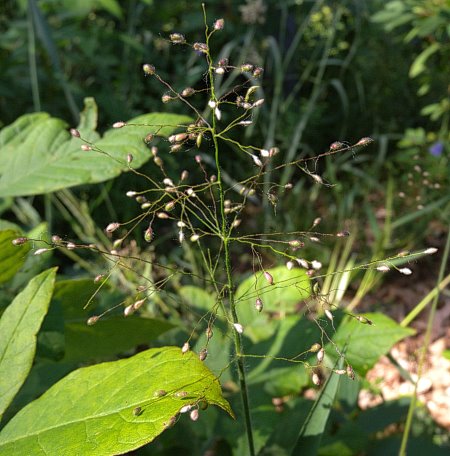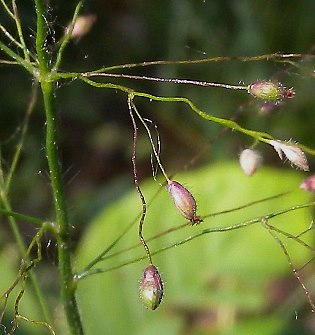
The central culm terminates in an exerted panicle of spikelets about 2-3½" long and 2-3" across. This inflorescence has an airy appearance and it is broadly ovoid-pyramidal in shape. Along the central axis of the panicle, there are lateral branches in groups of 1-3 that subdivide into pedicels about 0.5-1.0 cm. long; each pedicel terminates in a single-flowered spikelet. The central axis is slender, medium green, and sparsely hairy, while the slender lateral branches are wiry, hairless, and light to medium green. The lateral branches are ascending to widely spreading and stiff. The spikelets are 2.0-2.5 mm. in length and about one-half as much across; they are light green to purplish green (becoming light tan with age), ovoid-obovoid in shape, and hairy with fine longitudinal veins. Each spikelet consists of 2 glumes, a lemma, and a perfect floret. The shorter glume is about one-third the length of the spikelet and ovate in shape, while the longer glume and lemma are the same length as the spikelet. The blooming period of the vernal form occurs from late spring to early summer and lasts about 1 week. The florets are cross-pollinated by the wind. Afterwards, the autumnal form of this grass develops an abundance of low lateral branches that are leafy and resemble
 a rosette. The autumnal blades of this grass are a little
smaller in size than its vernal blades. Sometimes the lateral
branches
develop small panicles of florets that have fewer spikelets than the
vernal panicle. The mature grains of the spikelets are about 2 mm.
long, 1 mm. across, ovoid or broadly ellipsoid, slightly compressed,
light tan, and hairless. The root system consists of a shallow knotty
crown of fibrous roots.
a rosette. The autumnal blades of this grass are a little
smaller in size than its vernal blades. Sometimes the lateral
branches
develop small panicles of florets that have fewer spikelets than the
vernal panicle. The mature grains of the spikelets are about 2 mm.
long, 1 mm. across, ovoid or broadly ellipsoid, slightly compressed,
light tan, and hairless. The root system consists of a shallow knotty
crown of fibrous roots.Cultivation: The preference is full sun to light shade, mesic to dry conditions, and a somewhat acidic soil that is sandy, gravelly, or rocky.
Range & Habitat: The native White-Haired Panic Grass is occasional in northern, southern, and a small area of central Illinois, otherwise it is rare or absent (see Distribution Map). This map shows the combined distribution of the typical variety of Dichanthelium villosissimum and var. pseudopubescens. Habitats include sandy or rocky upland woods, sandy savannas, upland sand prairies and gravel prairies, sandstone glades and cliffs, and stabilized sand dunes near Lake Michigan. White-Haired Panic Grass is found in both open wooded areas and sunny areas that are relatively dry and sterile. Occasional disturbance that reduces woody vegetation is probably beneficial in maintaining populations of this grass.
Faunal Associations: Caterpillars of several skippers feed on panic grasses (Dichanthelium spp. and Panicum spp.), including Hesperia sassacus (Indian Skipper), Poanes hobomok (Hobomok Skipper), Polites themistocles (Tawny-Edged Skipper), and Wallengrenia egremet (Northern Broken Dash). Other insect feeders of these grasses include leaf-mining caterpillars of the moth Cycloplasis panicifoliella, the leaf beetle Chalepus bicolor, the stilt bug Jalysus spinosus, the stink bug Oebalus pugnax, and such leafhoppers as Flexamia areolata, Polyamia herbida, and Polyamia rossi. Among vertebrate animals, the Greater Prairie Chicken, Cowbird, Horned Lark, Dickcissel, Field Sparrow, Savannah Sparrow, Snow Bunting, and other birds eats the seeds of these grasses (see the Bird Table for a more complete listing of these species). The wild House Mouse and Prairie Deer Mouse also eat the seeds. The young foliage of panic grasses is palatable to many mammalian herbivores, including rabbits, horses, cattle, and sheep. Deer also browse on the autumnal form of the foliage during winter.
Photographic Location: A stabilized sand dune with scattered oak trees near Lake Michigan at the Indiana Dunes State Park in NW Indiana.

Comments: This panic grass is quite hairy. It is also rather variable as different varieties have been described with varying degrees of success. According to Mohlenbrock (1973/2001), the typical variety of White-Haired Panic Grass has culms and sheaths with widely spreading hairs, ligules that are 4-5 mm. long, and leaf blade upper surfaces that have appressed long hairs. Another variety, Dichanthelium villosissimum pseudopubescens, has culms and sheaths with appressed to ascending hairs, ligules that are 2-3 mm. long, and leaf blade upper surfaces that are either glabrous or short-hairy. However, some specimens of this grass display characteristics that are a mixture of these two varieties. Unlike Mohlenbrock, some authorities regard Dichanthelium praecocius as a variety of White-Haired Panic Grass, or Dichanthelium villosissimum praecocius. Generally, White-Haired Panic Grass can be distinguished from other panic grasses by its hairy foliage, hairy spikelets, the size of its spikelets (2.0-2.5 mm. long), and the width of its vernal leaf blades (4-10 mm. across).